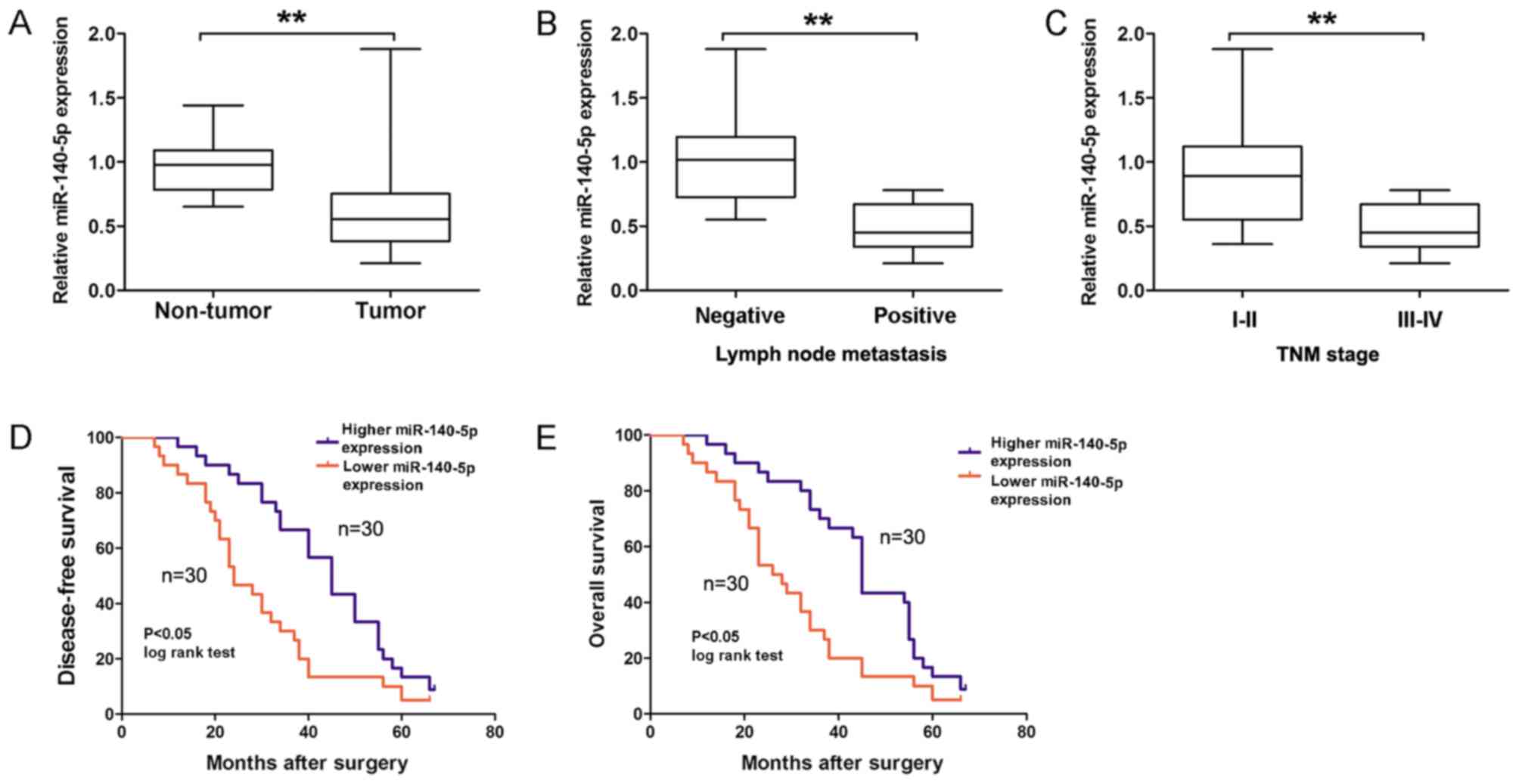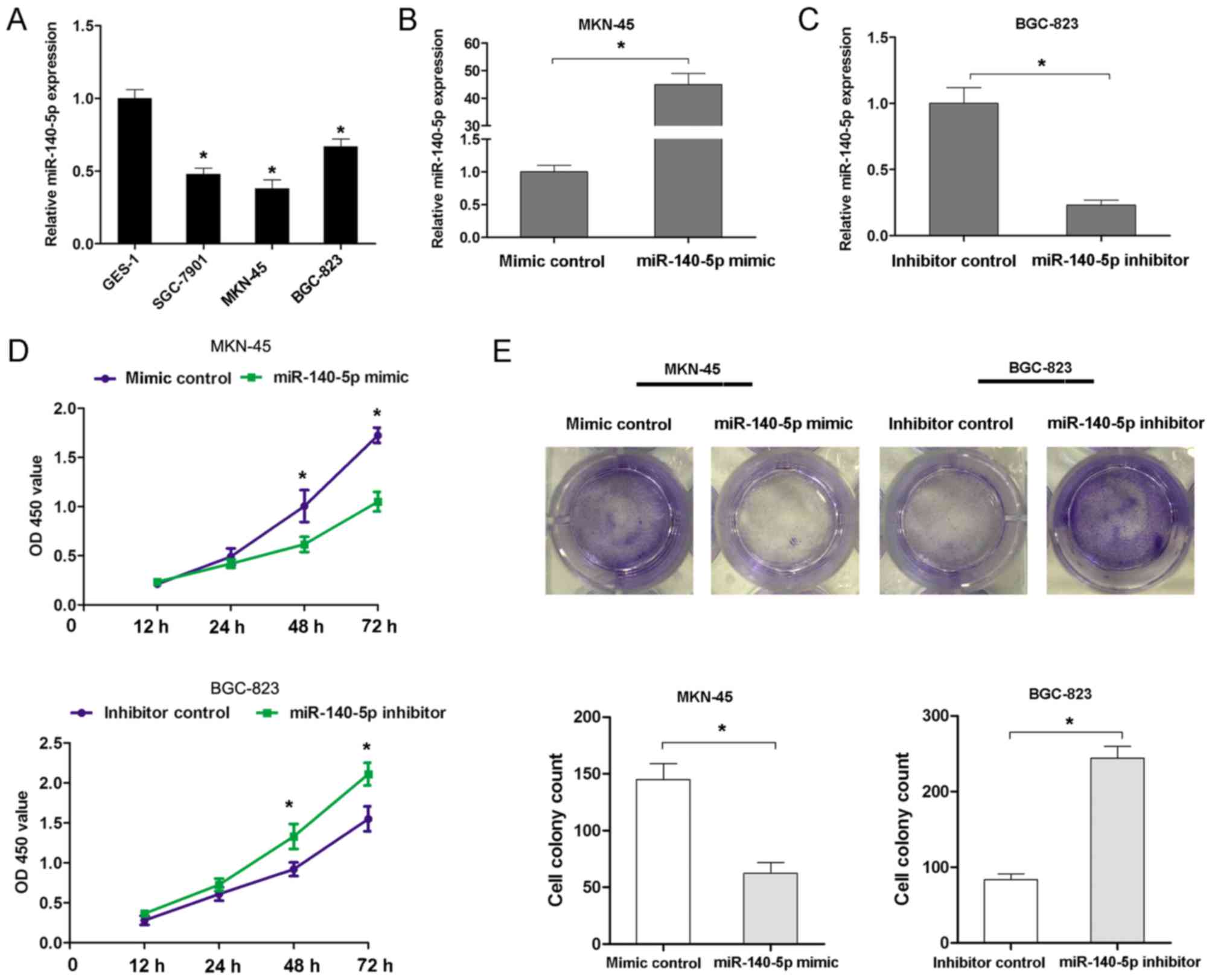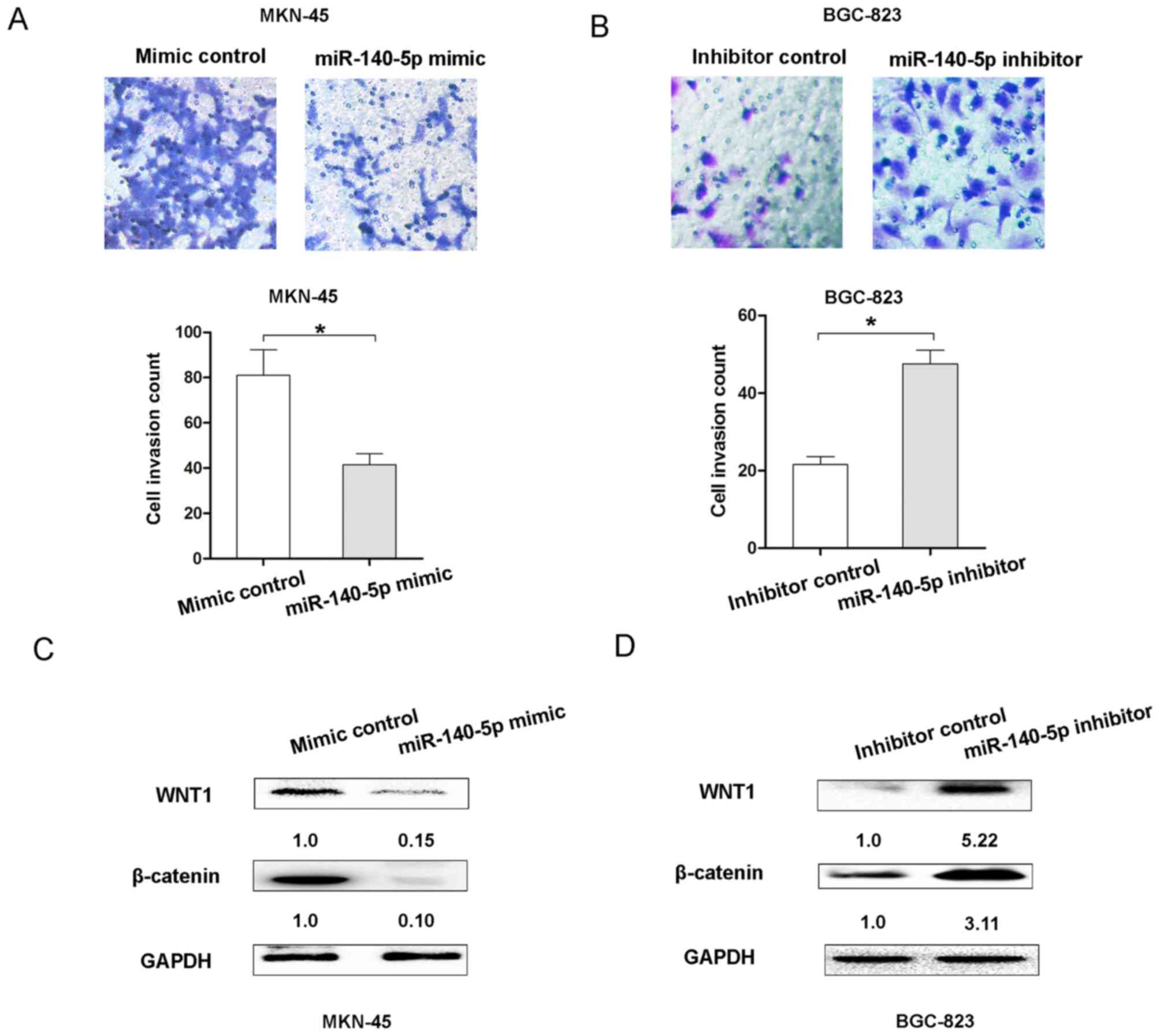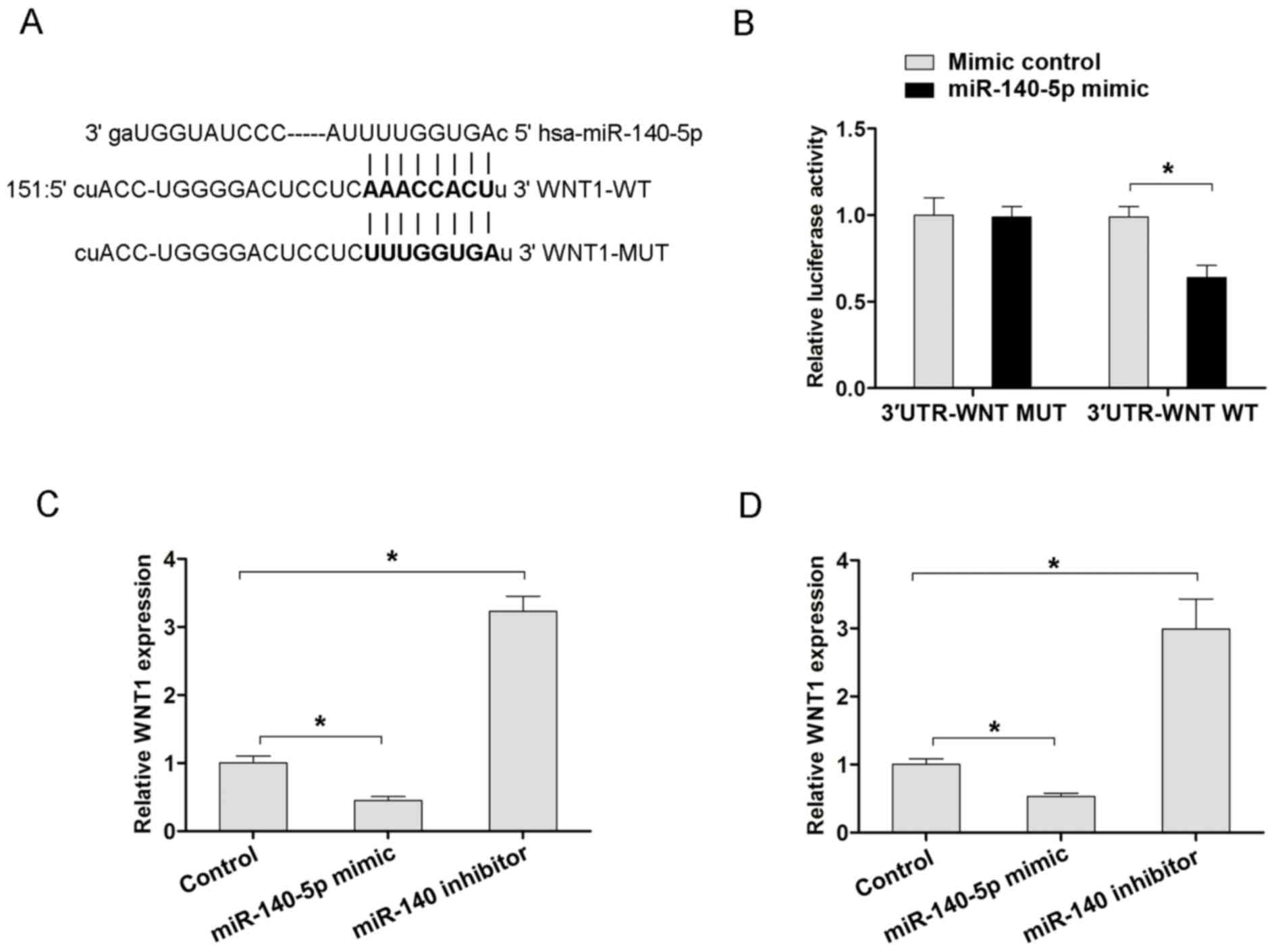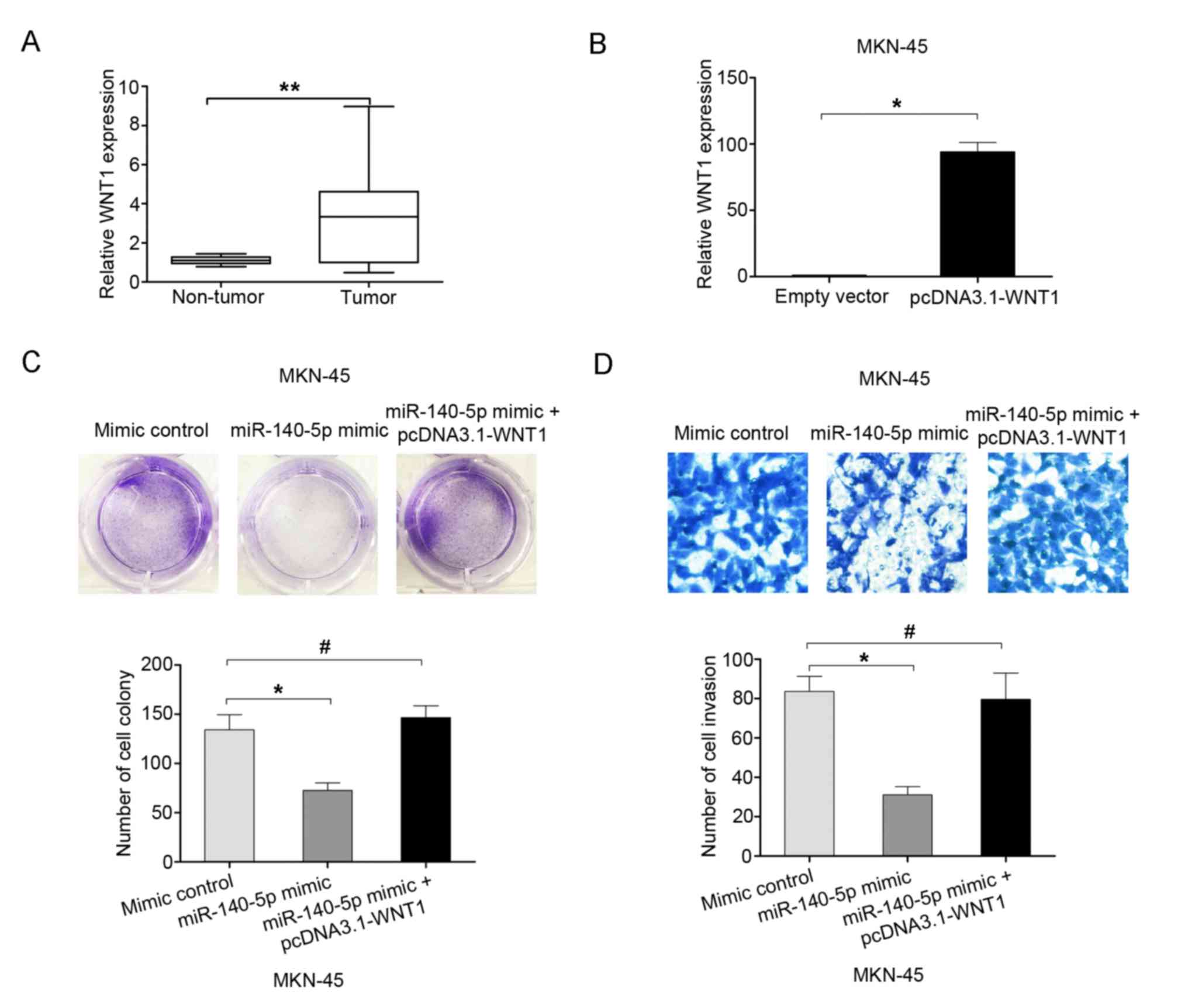MicroRNA‑140‑5p suppresses cell proliferation and invasion in gastric cancer by targeting WNT1 in the WNT/β‑catenin signaling pathway
- Authors:
- Published online on: September 21, 2018 https://doi.org/10.3892/ol.2018.9480
- Pages: 6369-6376
-
Copyright: © Cha et al. This is an open access article distributed under the terms of Creative Commons Attribution License.
Abstract
Introduction
Gastric cancer (GC) is an aggressive disease and a leading cause of cancer-associated mortality in China (1). A study reported 679,100 novel cases of GC in China, but the diagnostic rate of early GC remained extremely low at <10% in 2012 (1). Certain advances in GC therapy, including surgical resection with adjuvant chemotherapy or chemoradiation, have improved the overall survival time for patients with GC. However, due to tumor recurrence and metastasis at advanced stages, the disease continues to exhibit a poor prognosis (2,3). Therefore, studies investigating novel and more efficient tumor markers and potential targets for GC therapy are required.
MicroRNAs (miRNAs/miRs) are a class of small, regulatory non-coding RNAs involved in post-translational regulation by targeting the 3′-untranslated region (3′-UTR) of mRNA (4,5). miR-140-5p has been reported to function as a tumor suppressor in certain types of tumor. Jing et al (6) confirmed that microR-140-5p suppresses tumor cell migration and invasion by targeting the ADAM10-mediated Notch1 signaling pathway in hypopharyngeal squamous cell carcinoma. Wei et al (7) reported that miR-140-5p attenuates chemotherapeutic drug-induced cell death by regulating autophagy through inositol 1,4,5-trisphosphate kinase 2 in human osteosarcoma cells. In GC development, Fang et al (8) revealed that miR-140-5p suppresses the proliferation, migration and invasion of GC by regulating YES1. However, the underlying mechanisms of miR-140-5p involved in GC remain largely unknown.
The present study demonstrated that miR-140-5p, which was downregulated in GC tissues and cells, functioned as a tumor suppressor. Lower expression of miR-140-5p was revealed to be associated with a shorter survival time in patients with GC. Furthermore, it was demonstrated that miR-140-5p suppressed cell proliferation and invasion by targeting the WNT1-mediated Wnt/β-catenin signaling pathway. Therefore, the results of the present study indicated that miR-140-5p may serve as a prognostic maker for the survival of patients with GC and as a potential target of GC treatment.
Materials and methods
Patient tissue samples
The present study was approved by Huizhou Municipal Central Hospital of Guangdong Province (Huizhou, China). Written informed consent was obtained from all patients. A total of 60 paired GC tissues and adjacent non-tumor tissues were obtained from 42 male and 18 female patients (mean age, 52.5 years; range, 30–82 years), who underwent radical gastrectomy at Huizhou Municipal Central Hospital of Guangdong Province between March 2011 and April 2015. None of the patients had received any radiotherapy or chemotherapy prior to surgery. Tissue samples were snap-frozen in liquid nitrogen following surgery until further analyses. The clinical data of patients with GC are presented in Table I. All specimens had a confirmed pathological diagnosis and were staged according to the 2009 UICC-Tumor-Node-Metastasis (TNM) Classification of Malignant Tumors (9).
Cell line culture
The human GC MKN-45, BGC-823 and SGC-7901 cell lines, and the human immortalized normal gastric mucosa GES-1 cell line were purchased from the Shanghai Institute of Biochemistry and Cell Biology (Shanghai, China). Cells were cultured in RPMI-1640 medium (Thermo Fisher Scientific, Inc., Waltham, MA, USA), supplemented with 10% fetal bovine serum (Thermo Fisher Scientific, Inc.), 1% penicillin and 1% streptomycin, and were cultured at 37°C in humidified air with 5% CO2.
Cell transfection
The following sequences were constructed by and purchased from Shanghai GenePharma Co., Ltd. (Shanghai, China): miR-140-5p mimic, 5′-CAGUGGUUUUACCCUAUGGUAGACCAUAGGGUAAAACCACUGUU-3′; miR-140-5p inhibitor, 5′-AACCCAUGGAAUUCAGUUCUCA-3′ and the corresponding negative control, 5′-UUCUCCGAACGUGUCACGUTTACGUGACACGUUCGGAGAATT-3′. The cells were transfected with miR-140-5p mimic or inhibitor (100 nM) or respective negative control (NC), according to the manufacturer's protocol. The pcDNA3.1-WNT1 and the negative control (pcDNA3.1-vector) plasmids were obtained from Shanghai GenePharma Co., Ltd. Transfection was performed using Lipofectamine 2000 reagent (Invitrogen; Thermo Fisher Scientific, Inc.), according to the manufacturer's protocol. The RNA analysis and protein analysis were performed at 48 h following transfection.
Identification of potential target genes
TargetScan (www.targetscan.org) and MiRanda (www.microrna.org) databases were used for predicting the target gene of miR-140-5p.
Reverse transcription-quantitative polymerase chain reaction (RT-qPCR)
Total RNA was extracted from tissues and cells using TRIzol reagent (Takara, Dalian, China), according to the manufacturer's protocols. RNA was reverse transcribed to cDNA using a reverse transcription kit (Takara, Dalian, China) according to the manufacturer's protocols. RT-qPCR was performed using a SYBRGreen PCR kit (Takara, Dalian, China), according to the manufacturer's protocols. The reaction was performed on an Applied Biosystems Step One Plus Real-Time PCR system (Applied Biosystems; Thermo Fisher Scientific, Inc.). The relative expression of GAPDH or U6 was used as an internal control for WNT1 or miR-140-5p expression, respectively. The primer sequences were as follows: miR-140-5p forward, 5′-GAGTGTCAGTGGTTTTACCCT-3′ and reverse, 5′-GCAGGGTCCGAGGTATTC-3′; WNT1 forward, 5′-CTGTGCGAGAGTGCAAATGG-3′ and reverse, 5′-GATGAACGCTGTTTCTCGGC-3′; and GAPDH forward, 5′-AGACACCATGGGGAAGGTGAA-3′ and GAPDH reverse, 5′-ATTGCTGATGATCTTGAGGCTG-3′. The thermocycling conditions were as follows: 50°C for 2 min, followed by 40 cycles of 95°C for 15 sec and 60°C for 1 min. The mRNA expression was calculated using the 2−ΔΔCq methods (10).
Cell proliferation assay
A cell proliferation assay was performed using a CCK-8 kit (Dojindo Molecular Technologies, Inc., Kumamoto, Japan). In brief, 2,000 MKN-45 or BGC-823 cells/well were seeded into 96-well plates. Cells were cultured in RPMI-1640 medium, containing 10% FBS at 37°C in a humidified atmosphere with 5% CO2. Next, at indicated time points (12, 24, 48 and 72 h), CCK-8 solution (10 µl/well) was added into each well according to the manufacturer's protocols. Finally, cell proliferation rate was detected using a microplate reader (Bio-Rad Laboratories, Inc., Hercules, CA, USA) at an absorbance of 450 nm.
Colony formation assay
For the colony formation assay, 300 cells were transfected with miR-NC, miR-140-5p mimic or miR-140-5p inhibitor, and cultured on 12-well plates. After 14 days, cell colonies were fixed with 100% methanol for 20 min and stained with 0.1% crystal violet for 20 min at room temperature, and the number of cell colonies was calculated in randomly selected fields. The cell colony number was quantified by counting the colonies with >50 cells.
Cell invasion assay
A cell invasion assay was performed using 8-µm pores coated with Matrigel (BD Biosciences, Franklin Lakes, NJ, USA). A total of 1×105 MKN-45 or BGC-823 cells were resuspended in serum-free RPMI-1640 medium and seeded into the top chamber of the inserts, and 500 µl PRIM-1640 medium, supplemented with 10% FBS, was added to the lower chamber. Following cell transfection at 48 h, cells in the lower chamber were fixed with 100% methanol for 20 min at room temperature and stained with 0.1% crystal violet for 30 min at room temperature. Cells were counted under a light microscope (AZ100; Nikon Corporation, Tokyo, Japan) in ten randomly selected fields, ×200, magnification.
Western blot analysis
Total protein was isolated from transfected GC cells at 48 h after transfection using radioimmunoprecipitation assay buffer (Beyotime Institute of Biotechnology, Haimen, China). The concentration of protein was detected using a bicinchoninic acid protein assay kit (Beyotime Institute of Biotechnology), according to the manufacturer's protocols. Protein samples were separated on 10% SDS-PAGE and were transferred onto polyvinylidene difluoride membranes (Bio-Rad Laboratories, Inc.). Next, the membranes were incubated with primary antibodies against WNT1 (dilution, 1:3,000; cat. no. ab15251; Abcam, Cambridge, MA, USA and GAPDH (dilution, 1:3,000; cat. no. ab14247; Abcam) at 4°C overnight. Following incubation with horseradish peroxidase-conjugated anti-rabbit immunoglobulin G secondary antibodies (dilution, 1:5,000; cat. no. ab151318; Abcam) at room temperature for 1 h, the protein bands were visualized using an enhanced chemiluminescence system. GAPDH expression was used as an internal control.
Dual-luciferase reporter assay
The wild-type 3′-UTR of WNT1 mRNA that had a putative miR-140-5p binding site and mutant type 3′-UTR of WNT1 were inserted into pMIRGLO vectors (Promega Corporation, Madison, WI, USA). MKN-45 cells were co-transfected with miR-140-5p mimic or miR-negative control and pMIRGLO-wild type 3′UTR of WNT1 vector or pMIRGLO-mutant type 3′-UTR of WNT1 vector. Following cell transfection for 48 h, luciferase activity was detected using a dual-luciferase reporter assay system (E1910; Promega Corporation).
Statistical analysis
All the experiments in the present study were analyzed using SPSS 18.0 software (SPSS, Inc., Chicago, IL, USA). The results are presented as the mean ± standard deviation. Differences between two groups was analyzed using Student's t-test. Differences among groups were analyzed using one-way analysis of variance, followed by the Student-Newman-Keuls post hoc test. The χ2 test was used to assess the associations between miR-140-5p and clinicopathological factors in patients with GC. P<0.05 was considered to indicate a statistically significant difference.
Results
Expression of miR-140-5p is significantly downregulated in GC tissues and is associated with prognosis
The present study analyzed the miR-140-5p expression in 60 GC tissues and adjacent non-tumor tissues using RT-qPCR. As demonstrated in Fig. 1A, the relative expression of miR-140-5p was significantly downregulated in GC tissues compared with adjacent non-tumor tissues (P<0.01). Furthermore, miR-140-5p expression was divided into two (higher or lower expression) groups according to the median expression of miR-140-5p in GC tissues. Analysis results revealed that a lower miR-140-5p expression was significantly associated with lymph node metastasis (Fig. 1B; Table I; P=0.018) and advanced TNM stage (Fig. 1C; Table I; P=0.038) in patients with GC. Kaplan-Meier survival analysis revealed that a lower miR-140-5p expression predicted a poorer disease-free survival (DFS; Fig. 1D; log-rank=8.55; P<0.05) and overall survival (OS; Fig. 1E; log-rank=9.53; P<0.05) time in patients with GC, compared with the higher miR-140-5p expression group. Therefore, these results suggested that miR-140-5p expression was downregulated in GC and associated with GC prognosis.
miR-140-5p suppresses cell proliferation and invasion of GC in vitro
miR-140-5p expression was further investigated in three GC cell lines (MKN-45, BGC-823 and SGC-7901 cells) and GES-1 cells using RT-qPCR analyses. The results confirmed that miR-140-5p expression was notably lower in GC cell lines than in GES-1 cells (Fig. 2A). To assess the effects of miR-140-5p expression on proliferation and invasion, a gain-of-function assay was performed in MKN45 cells and a loss-of-function assay was performed in BGC-823 cells. The assays were performed according to the expression level of miR-140-5p in MKN-45 cells (higher expression level) and BGC-823 cells (lower expression level). The miR-140-5p mimic significantly increased the expression of miR-140-5p in MKN-45 cells, while the miR-140-5p inhibitor decreased the expression of miR-140-5p in BGC-823 cells (Fig. 2B and C). Transfection of MKN-45 cells with the miR-140 mimic significantly suppressed the cell proliferation rate at 48 and 72 h, but transfection of BGC-823 cells with the miR-140-5p inhibitor resulted in an increased cell proliferation rate at 48 and 72 h (Fig. 2D). Furthermore, transfection of MKN45 cells with miR-140 mimic resulted in the formation of fewer cell colonies, compared with the control group. However, transfection of BGC-823 cells with the miR-140-5p inhibitor significantly increased the cell colony number (Fig. 2E). Additionally, the present study examined whether miR-140-5p expression affected the invasion of GC cells. The Transwell cell invasion assay results demonstrated that transfection of MKN45 cells with the miR-140 mimic resulted in decreasing cell invasion ability, but transfection of BGC-823 cells with the miR-140-5p inhibitor enhanced cell invasion ability (Fig. 3A and B). Therefore, these results indicated that miR-140-5p could inhibit cell proliferation and invasion of GC in vitro.
miR-140-5p suppresses the Wnt/β-catenin signaling pathway by targeting WNT1 in GC cells
The Wnt/β-catenin signaling pathway was revealed to be associated with the proliferation and invasion of GC cells (11). To demonstrate whether miR-140-5p expression affected the Wnt/β-catenin signaling pathway, the expression of Wnt/β-catenin signaling molecules, WNT1 and β-catenin, was detected following upregulation or downregulation of miR-140-5p in GC cells. The results demonstrated that miR-140-5p overexpression suppressed the expression of WNT1 and β-catenin in MKN-45 cells, compared with the control group (Fig. 3C). However, decreasing miR-140-5p expression upregulated the expression levels of WNT1 and β-catenin in BGC-823 cells (Fig. 3D). These results indicated that miR-140-5p suppressed the Wnt/β-catenin signaling pathway in GC.
Furthermore, the TargetScan (www.targetscan.org) or MiRanda (www.microrna.org) databases were used to search potential target genes of miR-140-5p. From the miRanda data, it was revealed that WNT1 was a potential target of miR-140-5p (Fig. 4A). Furthermore, the WT 3′-UTR of WNT1 mRNA that had a putative miR-140-5p binding site and Mut type 3′-UTR of WNT1 were inserted into the pMIRGLO vectors, prior to luciferase assays being performed. The results revealed that miR-140-5p overexpression decreased the luciferase activity of WT 3′-UTR of the WNT1 vector, but not in the Mut 3′-UTR of the WNT1 in MKN45 cells (Fig. 4B). Furthermore, the present study also examined the mRNA expression of WNT1 following miR-140-5p overexpression or downregulation in MKN-45 and BGC-823 cells. Transfection with the miR-140-5p mimic in MKN45 and BGC-823 cells resulted in decreased WNT1 mRNA, but transfection with the miR-140-5p inhibitor exhibited increased WNT1 mRNA expression, compared with the corresponding control groups (Fig. 4C and D). Therefore, the aforementioned results indicated that WNT1 is a target of miR-140-5p, and that miR-140-5p suppressed the Wnt/β-catenin signaling pathway by targeting WNT1 in GC.
Overexpression of WNT1 reverses the effects of miR-140-5p on the proliferation and invasion of GC cells
The expression of WNT1 was examined in 60 GC tissues and adjacent non-tumor tissues using RT-qPCR analyses. The results indicated that WNT1 mRNA expression was higher in GC tissues than in adjacent non-tumor tissues (Fig. 5A). To demonstrate whether WNT mediated the effects of miR-140-5p on the proliferation and invasion of GC cells, rescue experiments were performed by overexpressing WNT1 using the pcDNA3.1-WNT1 plasmid in MKN-45 cells (Fig. 5B). The cell colony formation assay results demonstrated that the cell proliferation ability was inhibited following miR-140-5p overexpression in MKN-45 cells, but this effect was reversed by co-transfection with miR-140-5p mimic and pcDNA3.1-WNT1 (Fig. 5C). The cell invasion assay results demonstrated that cell invasion ability was inhibited following miR-140-5p overexpression in MKN-45 cells, but the effect was reversed by co-transfection with miR-140-5p mimic and pcDNA3.1-WNT1 (Fig. 5D). Therefore, the results of the present study indicated that overexpression of WNT1 may reverse the effects of miR-140-5p on cell proliferation and invasion.
Discussion
Recent studies have indicated that deregulation of miRNAs contributes toward the tumorigenesis and progression of GC (12,13). miR-140-5p acts as tumor suppressor to serve important regulatory roles in cancer development. miR-140-5p suppresses tumor growth and metastasis by targeting transforming growth factor β receptor 1 and fibroblast growth factor 9 in hepatocellular carcinoma (14). miR-140-5p could suppress the proliferation of lung cancer cells by regulating Erk signaling (15). Overexpression of hsa-miR-140-5p in colorectal cancer (CRC) cell lines decreases Smad2 expression levels, leading to decreased cell invasion and proliferation, and increased cell cycle arrest (16). miR-140-5p was significantly downregulated in CRC and inhibits the progression of CRC by targeting VEGFA (17). The present study demonstrated that miR-140-5p was significantly downregulated in GC. Lower miR-140-5p expression was significantly associated with lymph node metastasis and advanced clinical stages in patients with GC. A recent study also demonstrated that miR-140-5p suppresses the proliferation, migration and invasion of GC by regulating YES1 (8). Additionally, the present study demonstrated that miR-140-5p overexpression inhibited cell proliferation and invasion ability.
Furthermore, it was demonstrated that miR-140-5p suppressed the Wnt/β-catenin signaling pathway. Additionally, the Wnt/β-catenin signaling pathway has been identified as a key signaling pathway in the proliferation, invasion and metastatic cascade of GC cells (18,19). A previous study undertaken by Yue et al (20) reported that miR-519d suppresses the GC epithelial-mesenchymal transition via Twist1 and inhibits the Wnt/β-catenin signaling pathway. Wu et al (21) demonstrated that miRNA-27a promotes the proliferation and invasion of human GC MGC803 cells by targeting SFRP1 via the Wnt/β-catenin signaling pathway. miR-194 activates the Wnt/β-catenin signaling pathway in GC by targeting the negative Wnt regulator, SUFU (22). Another study revealed that LINC00052 promotes GC cell proliferation and metastasis via activating the Wnt/β-Catenin signaling pathway (23). These studies have identified the importance of the Wnt/β-Catenin signaling pathway in GC progression. The present study demonstrated that miR-140-5p suppressed the Wnt/β-Catenin signaling pathway by targeting the 3′-UTR region of WNT1 (a key molecule of the Wnt/β-Catenin signaling pathway), and regulated its mRNA and protein expression. In addition, the present study demonstrated that overexpression of WNT1 could reverse the effects of miR-140-5p on cell proliferation and invasion. Therefore, these results indicated that miR-140-5p suppressed cell proliferation and invasion by regulating the WNT1-mediated Wnt/β-Catenin signaling pathway in GC.
In conclusion, the results of the present study indicated that miR-140-5p was downregulated in GC and that a lower expression of miR-140-5p predicted a poorer prognosis in patients with GC. Furthermore, it was revealed that miR-140-5p suppressed cell proliferation and invasion. Additionally, the present study demonstrated that miR-140-5p inhibited the Wnt/β-Catenin signaling pathway by targeting WNT1. Therefore, these results indicated that miR-140-5p may serve as a prognostic biomarker of GC and a potential target for GC treatment.
Acknowledgements
Not applicable.
Funding
No funding was received.
Availability of data and materials
The datasets used and/or analyzed during the present study are available from the corresponding author on reasonable request.
Authors' contributions
YC, YH and KO performed the experiments in the present study. HX, JL and XY performed the data analysis and YC and XY designed the present study and wrote the manuscript.
Ethics approval and consent to participate
The present study was approved by Huizhou Municipal Central Hospital of Guangdong Province (Huizhou, China). Written informed consent was obtained from all patients.
Patient consent for publication
All participants agreed to the publication of the present study.
Competing interests
The authors declare that they have no competing interests.
References
|
Leja M, You W, Camargo MC and Saito H: Implementation of gastric cancer screening-the global experience. Best Pract Res Clin Gastroenterol. 28:1093–1106. 2014. View Article : Google Scholar : PubMed/NCBI | |
|
Carcas LP: Gastric cancer review. J Carcinog. 13:142014. View Article : Google Scholar : PubMed/NCBI | |
|
Rao M, Zhu Y, Cong X and Li Q: Knockdown of CREB1 inhibits tumor growth of human gastric cancer in vitro and in vivo. Oncol Rep. 37:3361–3368. 2017. View Article : Google Scholar : PubMed/NCBI | |
|
Bartel DP: MicroRNAs: Genomics, biogenesis, mechanism, and function. Cell. 116:281–297. 2004. View Article : Google Scholar : PubMed/NCBI | |
|
Xie M, Dart DA, Guo T, Xing XF, Cheng XJ, Du H, Jiang WG, Wen XZ and Ji JF: MicroRNA-1 acts as a tumor suppressor microRNA by inhibiting angiogenesis-related growth factors in human gastric cancer. Gastric Cancer. 21:41–54. 2018. View Article : Google Scholar : PubMed/NCBI | |
|
Jing P, Sa N, Liu X, Liu X and Xu W: MicroR-140-5p suppresses tumor cell migration and invasion by targeting ADAM10-mediated Notch1 signaling pathway in hypopharyngeal squamous cell carcinoma. Exp Mol Pathol. 100:132–138. 2016. View Article : Google Scholar : PubMed/NCBI | |
|
Wei R, Cao G, Deng Z, Su J and Cai L: miR-140-5p attenuates chemotherapeutic drug-induced cell death by regulating autophagy through inositol 1,4,5-trisphosphate kinase 2 (IP3k2) in human osteosarcoma cells. Biosci Rep. 36:e003922016. View Article : Google Scholar : PubMed/NCBI | |
|
Fang Z, Yin S, Sun R, Zhang S, Fu M, Wu Y, Zhang T, Khaliq J and Li Y: miR-140-5p suppresses the proliferation, migration and invasion of gastric cancer by regulating YES1. Mol Cancer. 16:1392017. View Article : Google Scholar : PubMed/NCBI | |
|
Novák J and Fabian P: Comments on the TNM classification of malignant tumours-7th edition. Klin Onkol. 24:149–150. 2011.(In Czech). PubMed/NCBI | |
|
Livak KJ and Schmittgen TD: Analysis of relative gene expression data using real-time quantitative PCR and the 2(-Delta Delta C(T)) method. Methods. 25:402–408. 2001. View Article : Google Scholar : PubMed/NCBI | |
|
Zhang T, Wu Y, Fang Z, Yan Q, Zhang S, Sun R, Khaliq J and Li Y: Low expression of RBMS3 and SFRP1 are associated with poor prognosis in patients with gastric cancer. Am J Cancer Res. 6:2679–2689. 2016.PubMed/NCBI | |
|
Wang J, Chen X, Su L, Li P, Cai Q, Liu B, Wu W and Zhu Z: MicroRNA-126 inhibits cell proliferation in gastric cancer by targeting LAT-1. Biomed Pharmacother. 72:66–73. 2015. View Article : Google Scholar : PubMed/NCBI | |
|
Xiang XJ, Deng J, Liu YW, Wan LY, Feng M, Chen J and Xiong JP: MiR-1271 inhibits cell proliferation, invasion and EMT in gastric cancer by targeting FOXQ1. Cell Physiol Biochem. 36:1382–1394. 2015. View Article : Google Scholar : PubMed/NCBI | |
|
Yang H, Fang F, Chang R and Yang L: MicroRNA-140-5p suppresses tumor growth and metastasis by targeting transforming growth factor β receptor 1 and fibroblast growth factor 9 in hepatocellular carcinoma. Hepatology. 58:205–217. 2013. View Article : Google Scholar : PubMed/NCBI | |
|
Li W and He F: Monocyte to macrophage differentiation-associated (MMD) targeted by miR-140-5p regulates tumor growth in non-small cell lung cancer. Biochem Biophys Res Commun. 450:844–850. 2014. View Article : Google Scholar : PubMed/NCBI | |
|
Zhai H, Fesler A, Ba Y, Wu S and Ju J: Inhibition of colorectal cancer stem cell survival and invasive potential by hsa-miR-140-5p mediated suppression of Smad2 and autophagy. Oncotarget. 6:19735–19746. 2015. View Article : Google Scholar : PubMed/NCBI | |
|
Zhang W, Zou C, Pan L, Xu Y, Qi W, Ma G, Hou Y and Jiang P: MicroRNA-140-5p inhibits the progression of colorectal cancer by targeting VEGFA. Cell Physiol Biochem. 37:1123–1133. 2015. View Article : Google Scholar : PubMed/NCBI | |
|
Yu Y, Yan W, Liu X, Jia Y, Cao B, Yu Y, Lv Y, Brock MV, Herman JG, Licchesi J, et al: DACT2 is frequently methylated in human gastric cancer and methylation of DACT2 activated Wnt signaling. Am J Cancer Res. 4:710–724. 2014.PubMed/NCBI | |
|
Nunez F, Bravo S, Cruzat F, Montecino M and De Ferrari GV: Wnt/β-catenin signaling enhances cyclooxygenase-2 (COX2) transcriptional activity in gastric cancer cells. PLoS One. 6:e185622011. View Article : Google Scholar : PubMed/NCBI | |
|
Yue H, Tang B, Zhao Y, Niu Y, Yin P, Yang W, Zhang Z and Yu P: MIR-519d suppresses the gastric cancer epithelial-mesenchymal transition via Twist1 and inhibits Wnt/β-catenin signaling pathway. Am J Transl Res. 9:3654–3664. 2017.PubMed/NCBI | |
|
Wu F, Li J, Guo N, Wang XH and Liao YQ: MiRNA-27a promotes the proliferation and invasion of human gastric cancer MGC803 cells by targeting SFRP1 via Wnt/β-catenin signaling pathway. Am J Cancer Res. 7:405–416. 2017.PubMed/NCBI | |
|
Peng Y, Zhang X, Ma Q, Yan R, Qin Y, Zhao Y, Cheng Y, Yang M, Wang Q, Feng X, et al: MiRNA-194 activates the Wnt/β-catenin signaling pathway in gastric cancer by targeting the negative Wnt regulator, SUFU. Cancer Lett. 385:117–127. 2017. View Article : Google Scholar : PubMed/NCBI | |
|
Shan Y, Ying R, Jia Z, Kong W, Wu Y, Zheng S and Jin H: LINC00052 promotes gastric cancer cell proliferation and metastasis via activating Wnt/β-catenin signaling pathway. Oncol Res. 25:1589–1599. 2017. View Article : Google Scholar : PubMed/NCBI |



